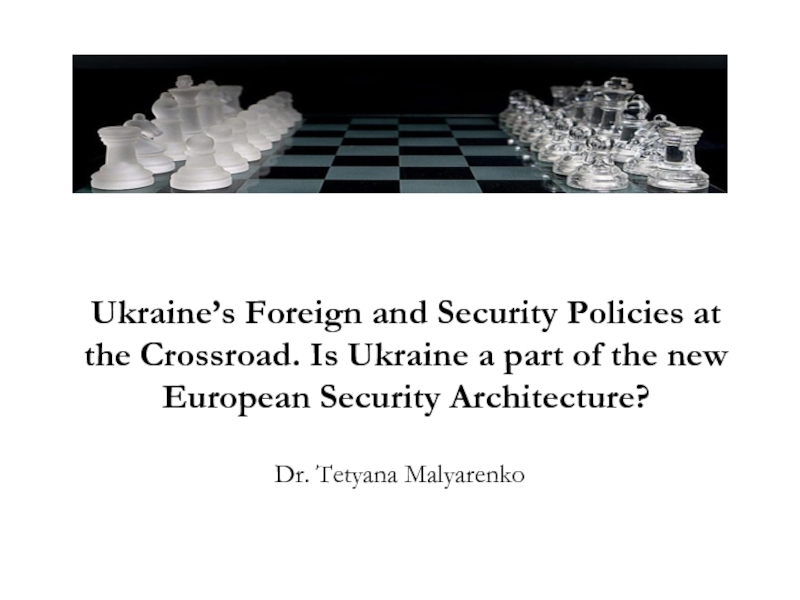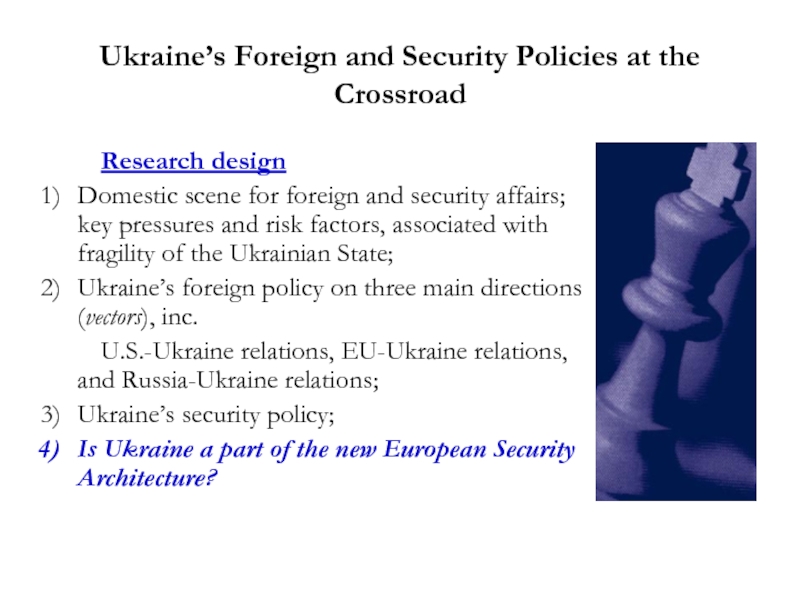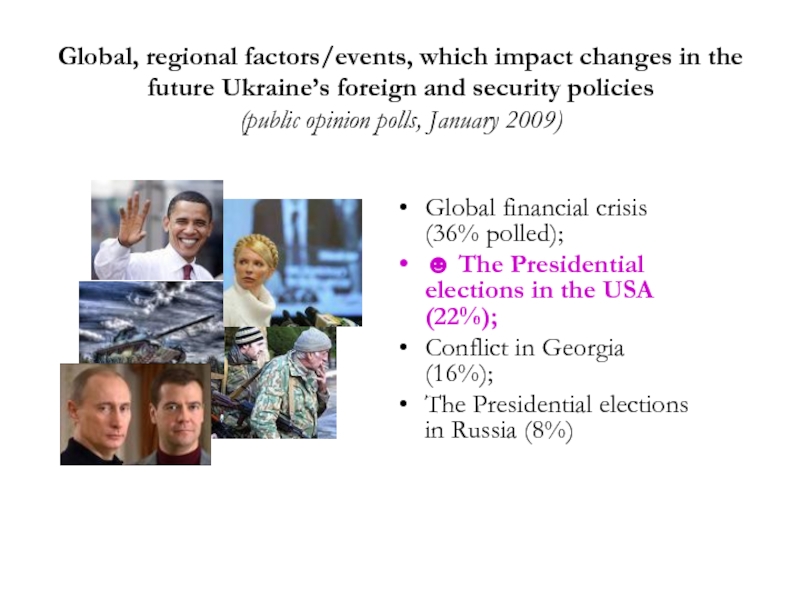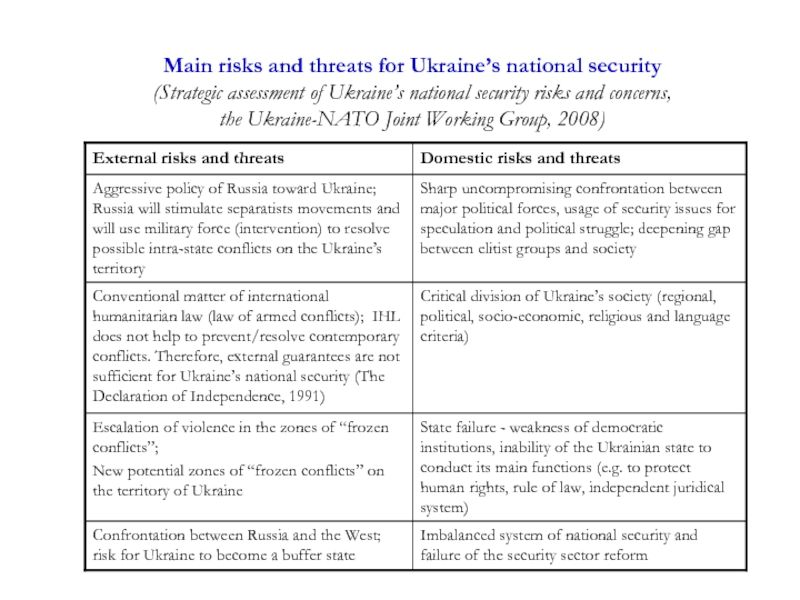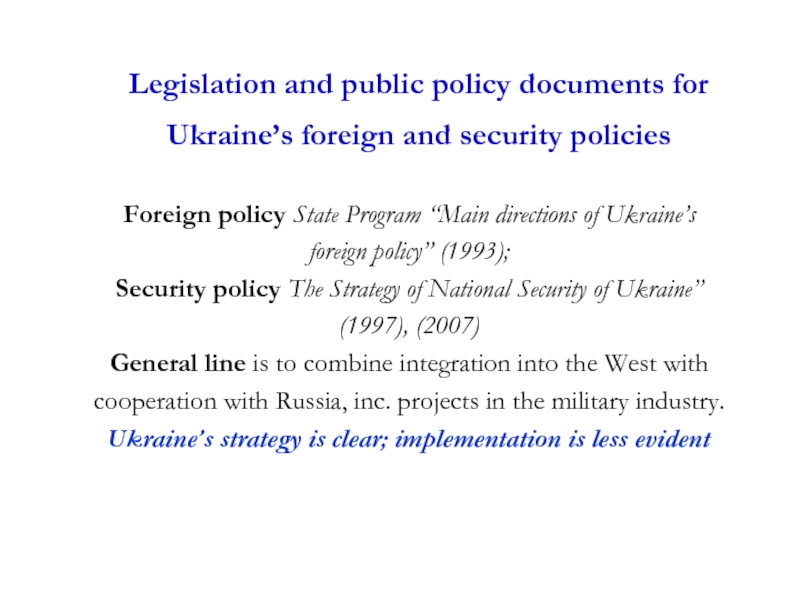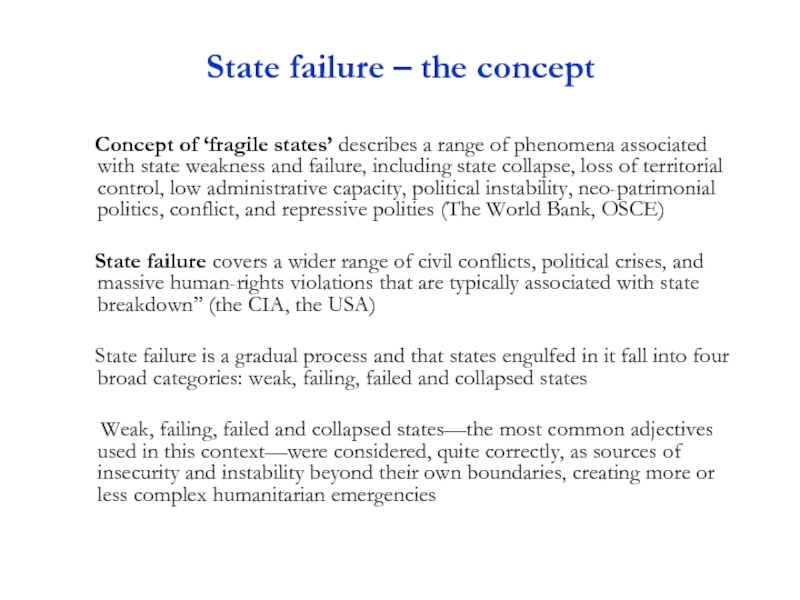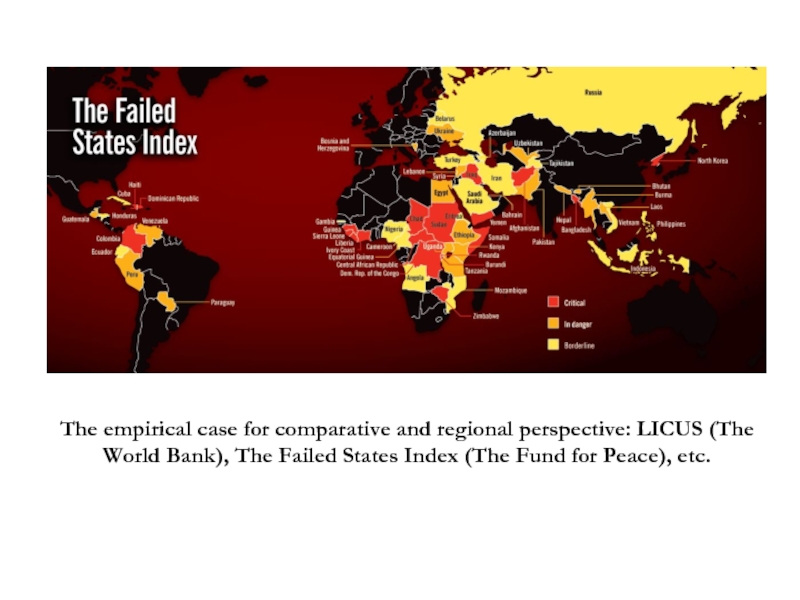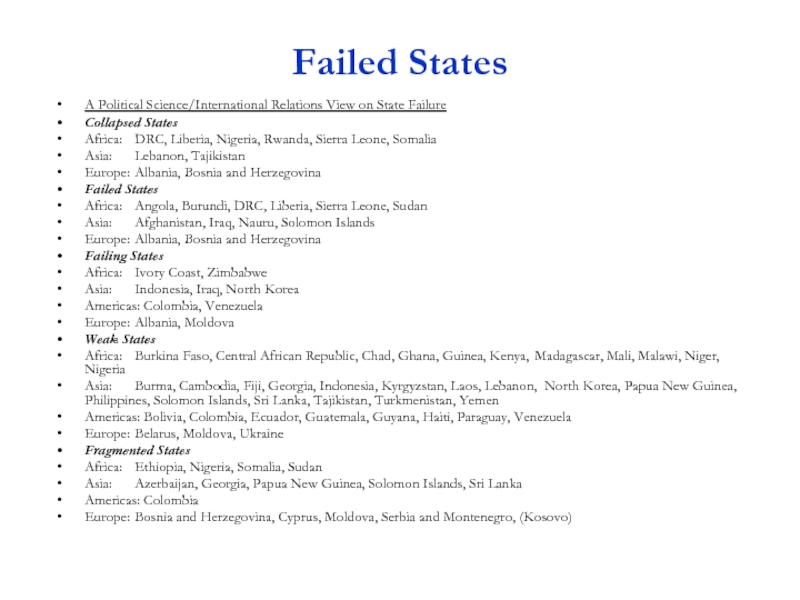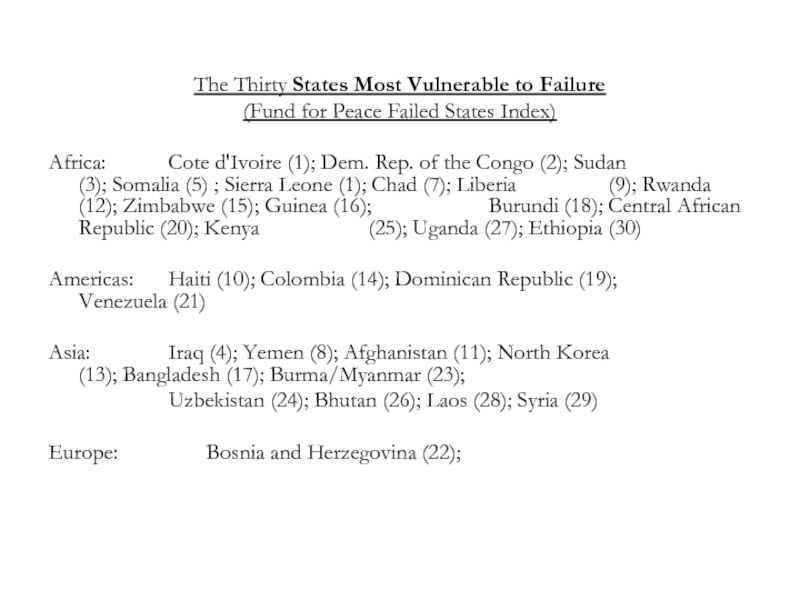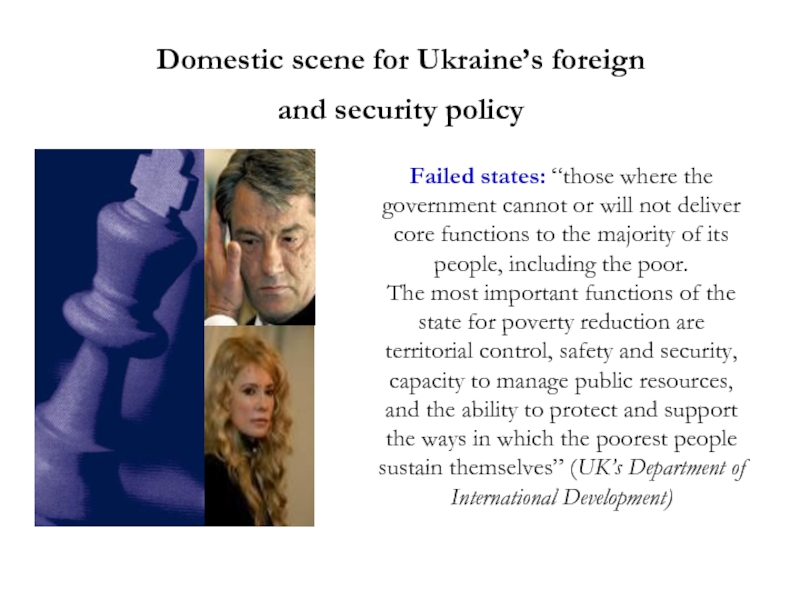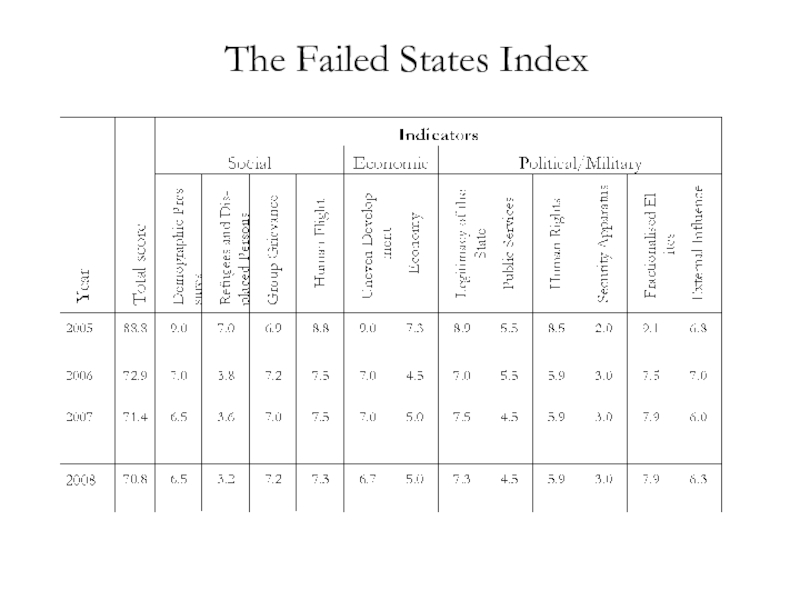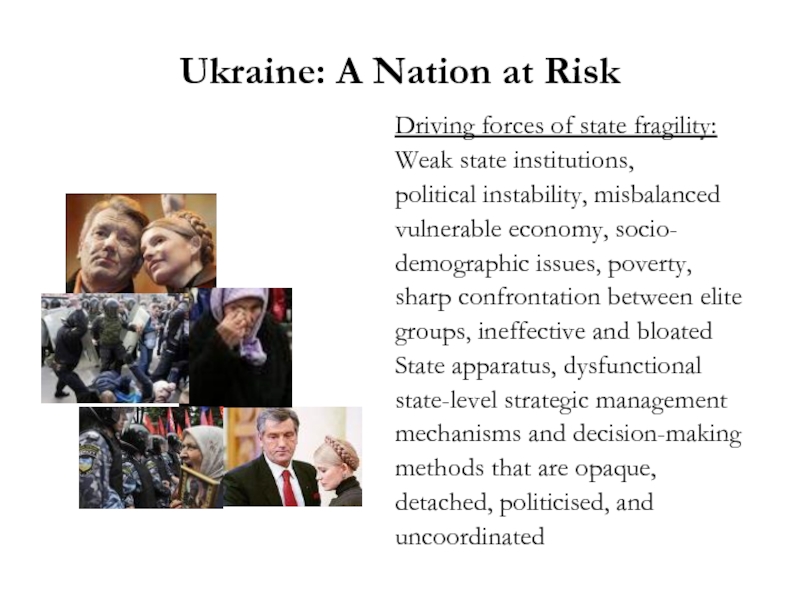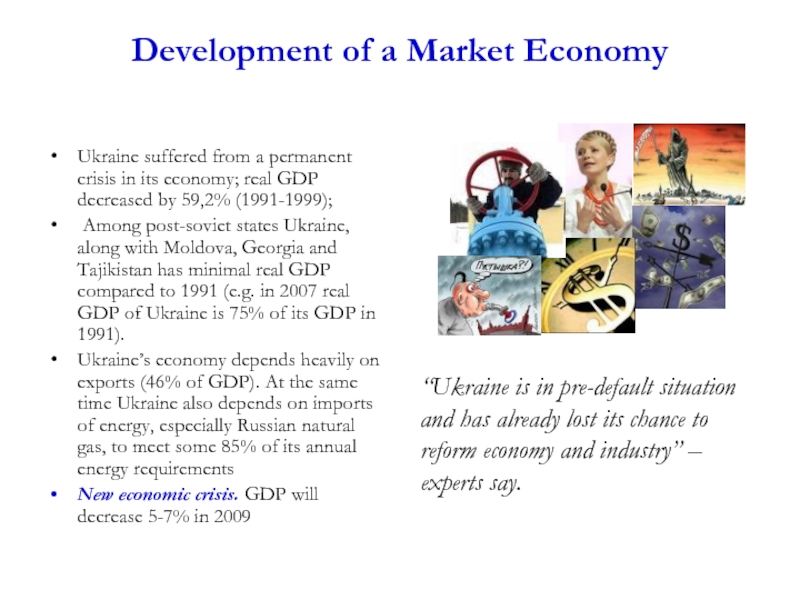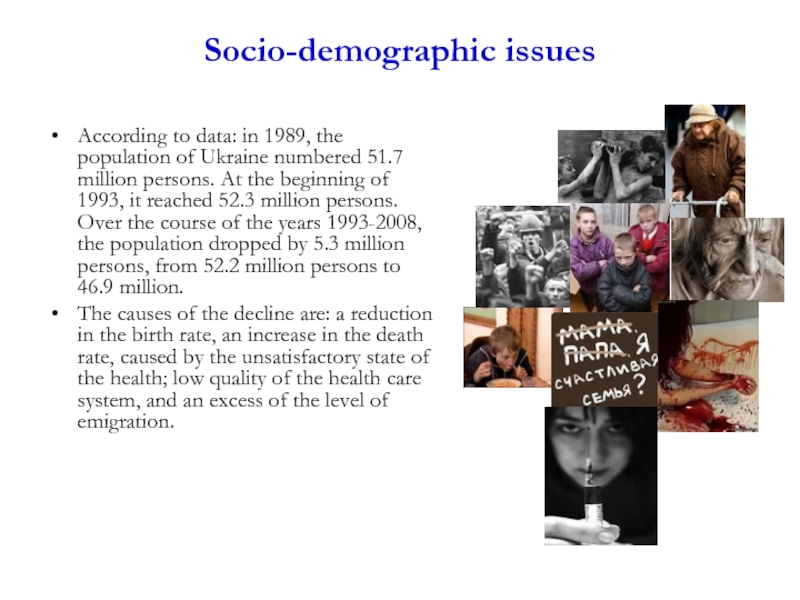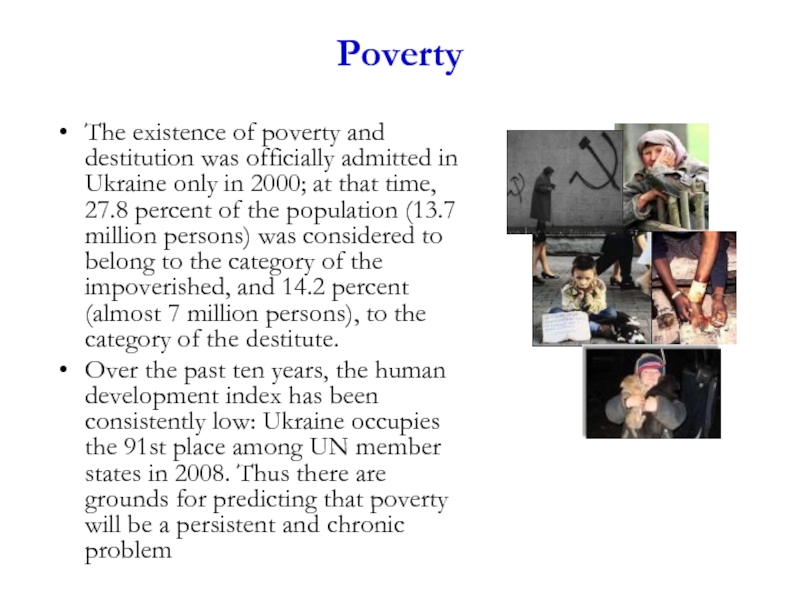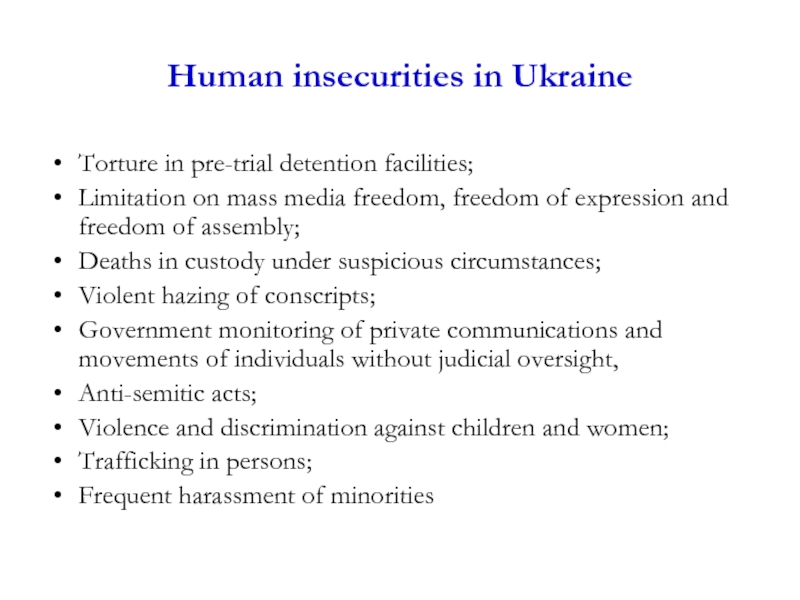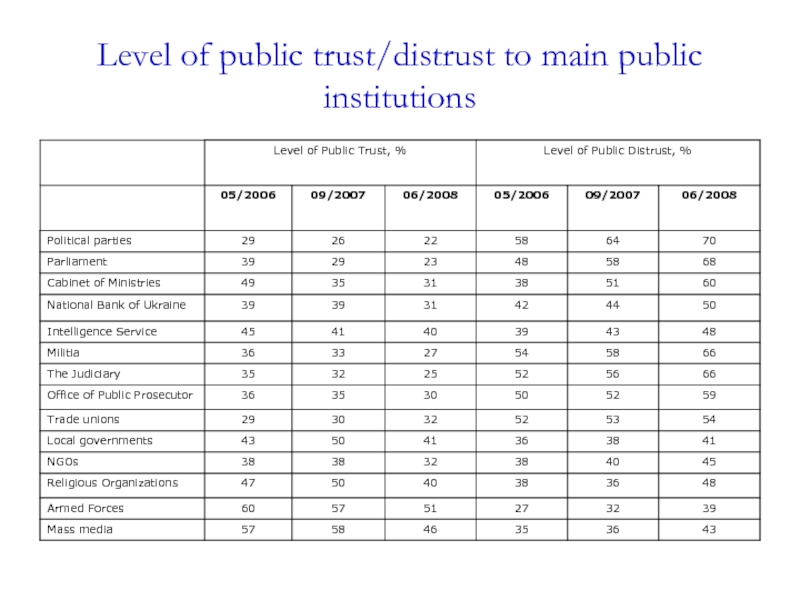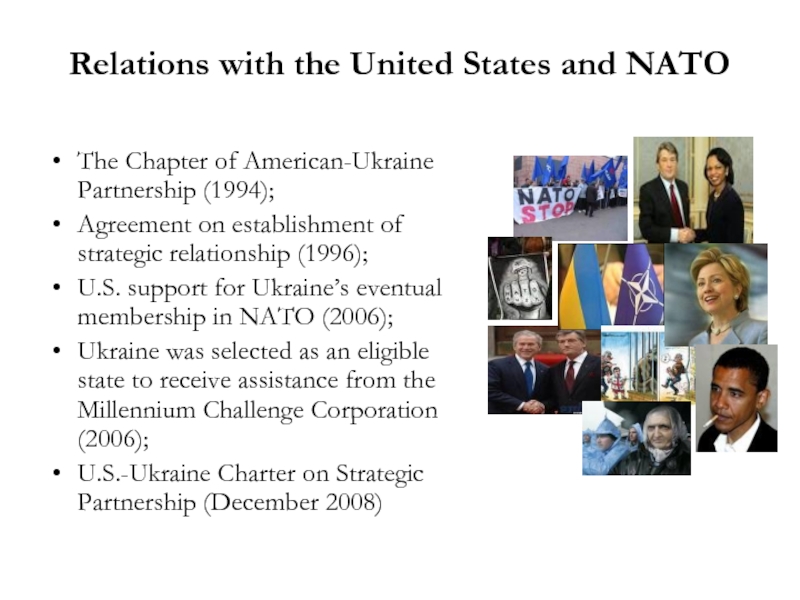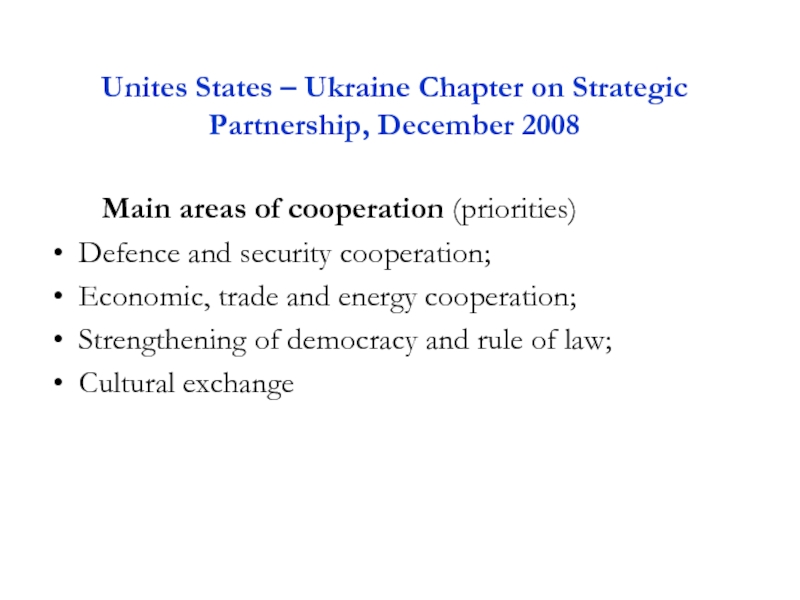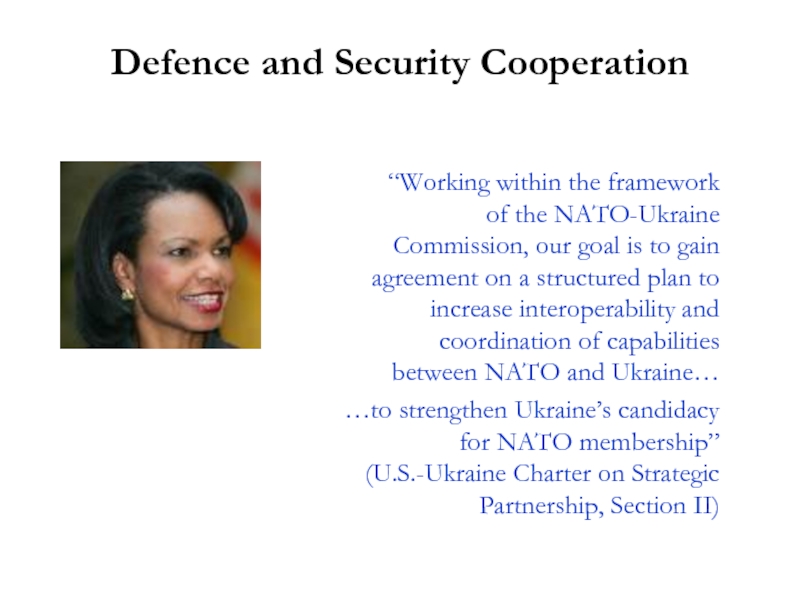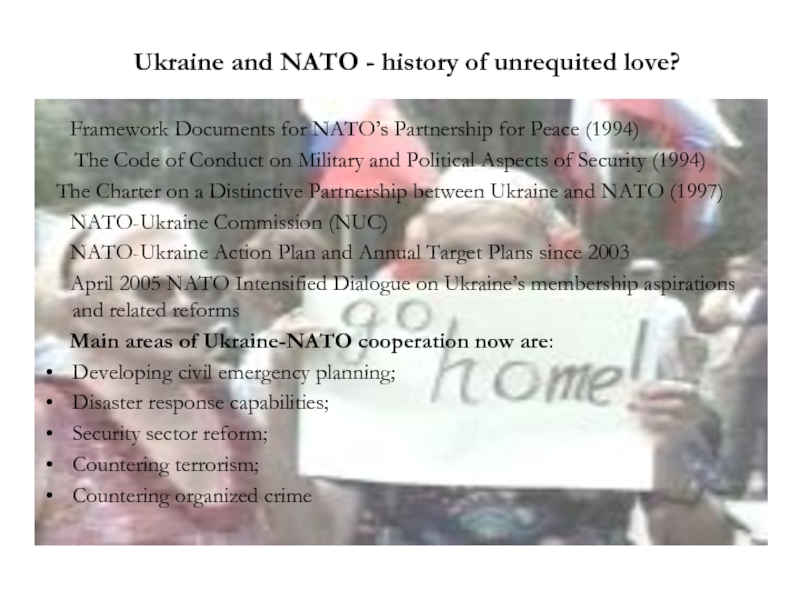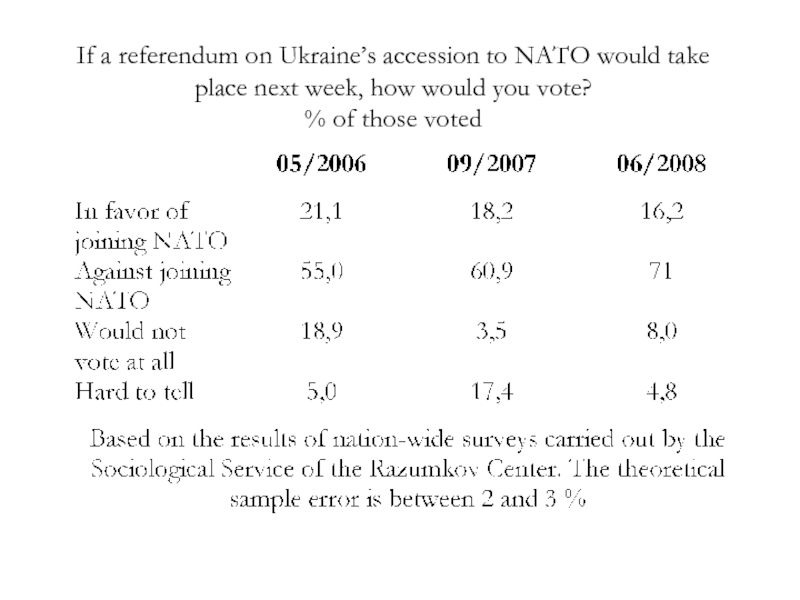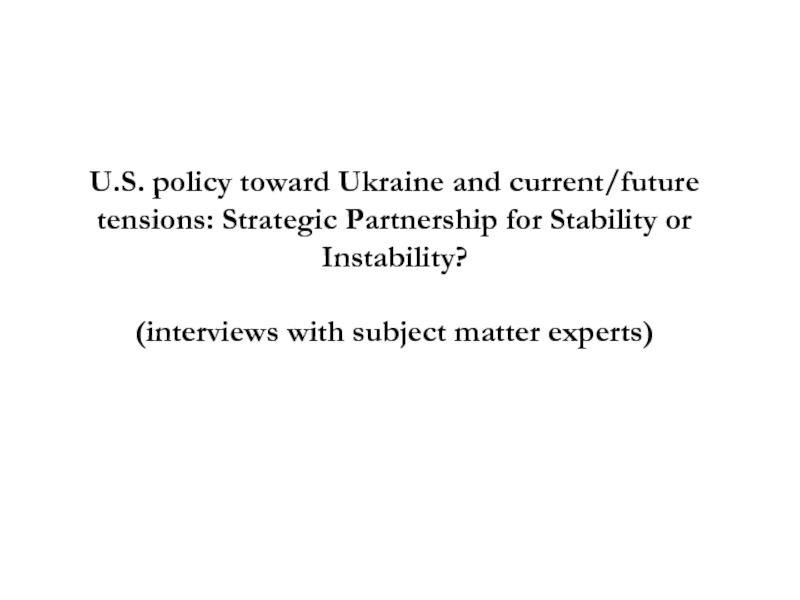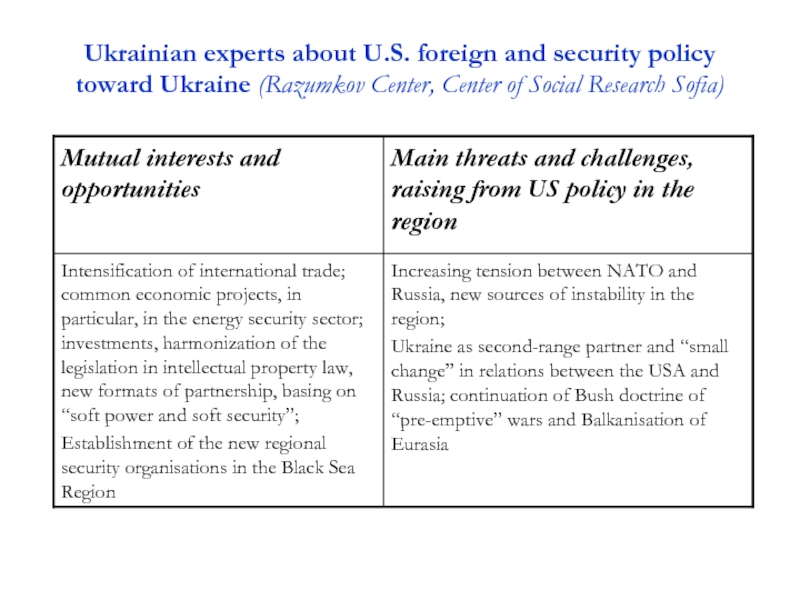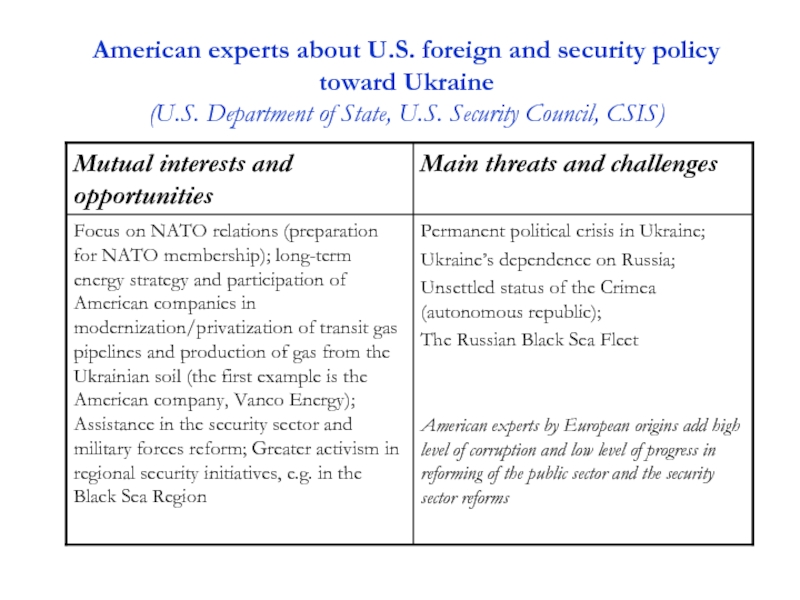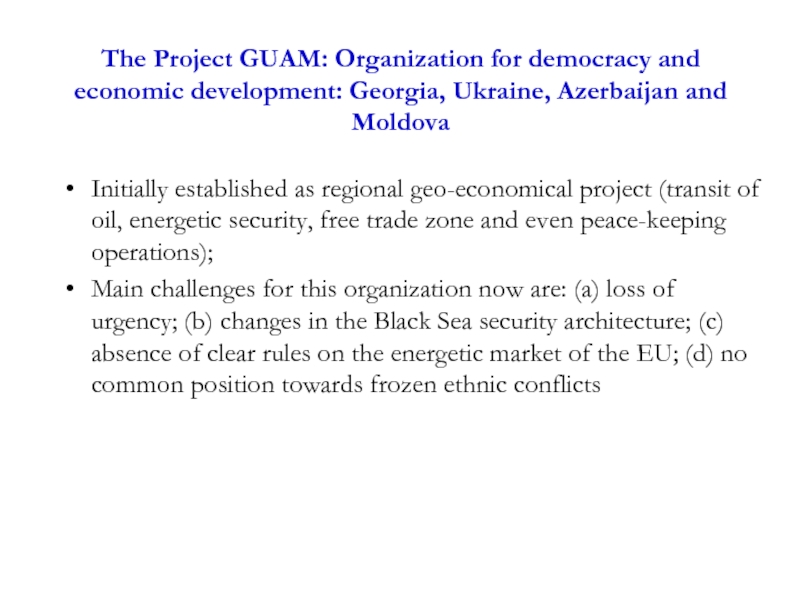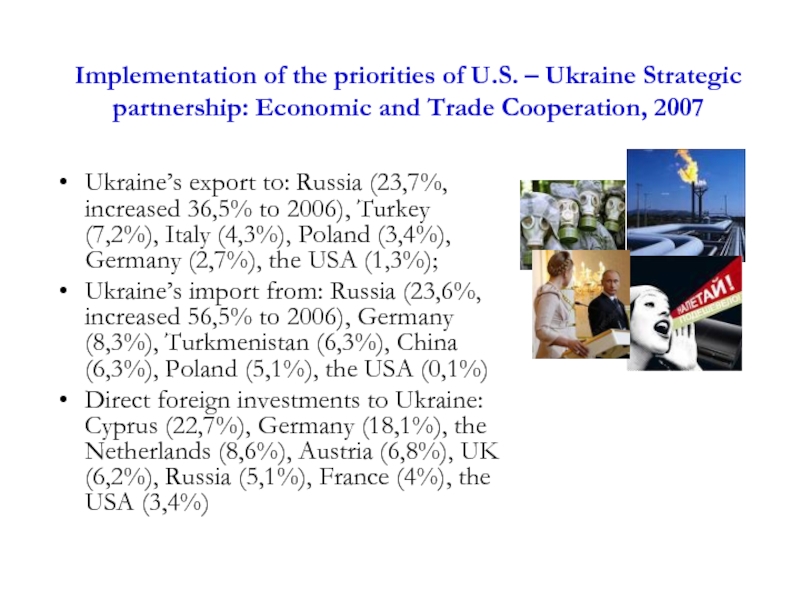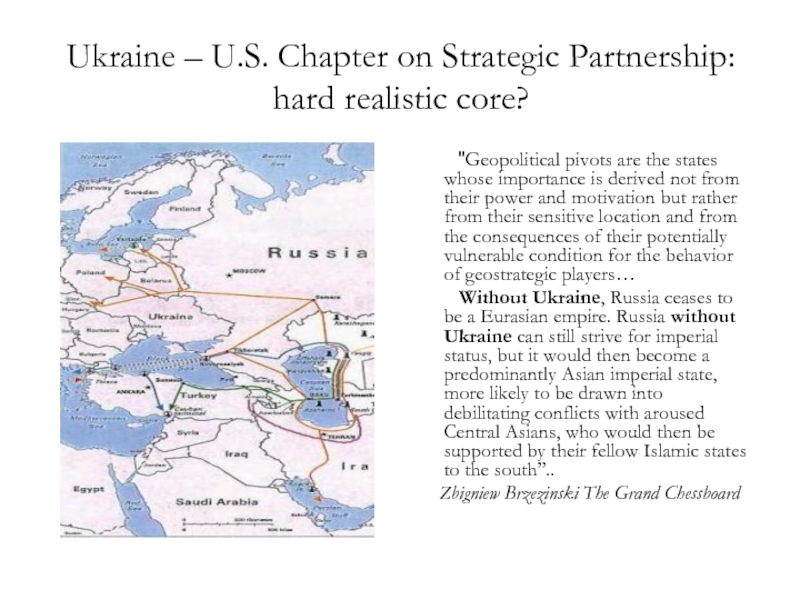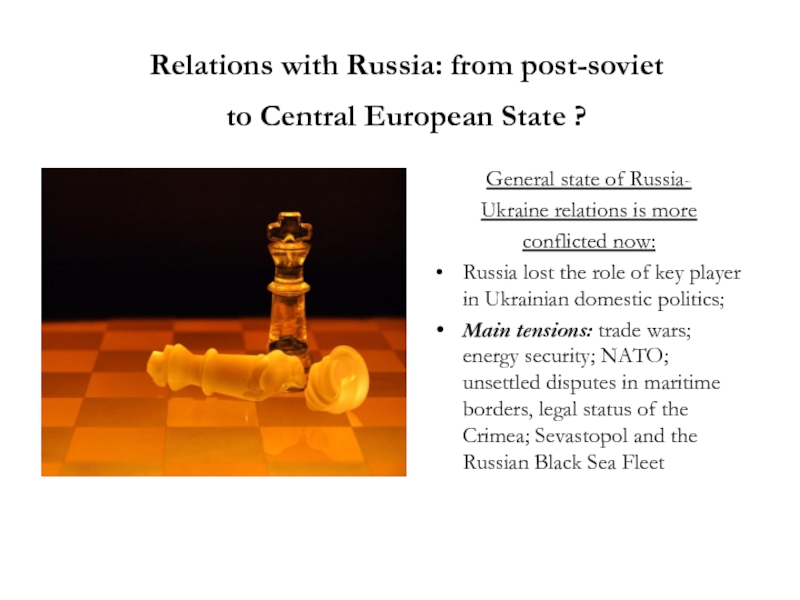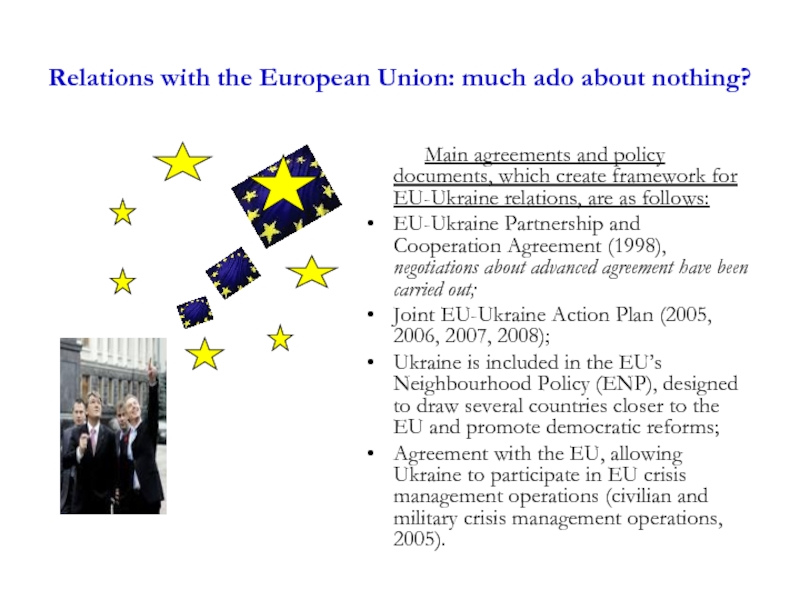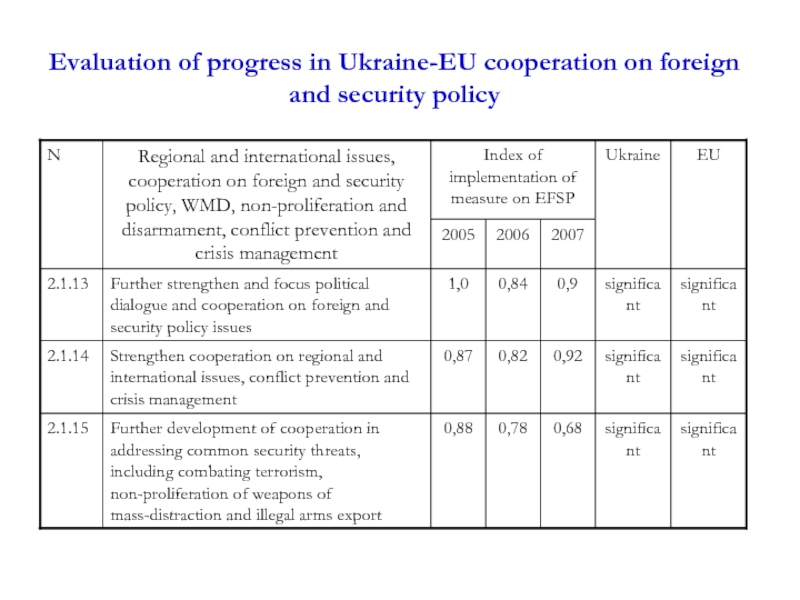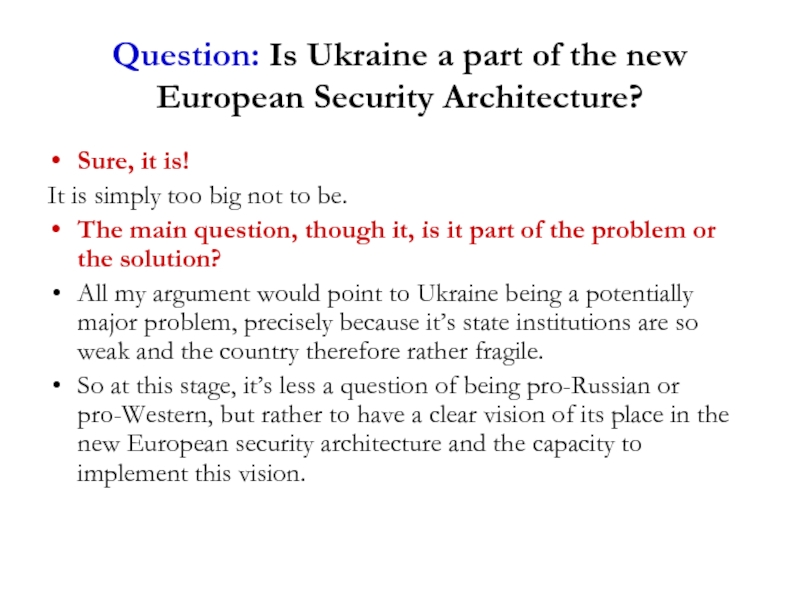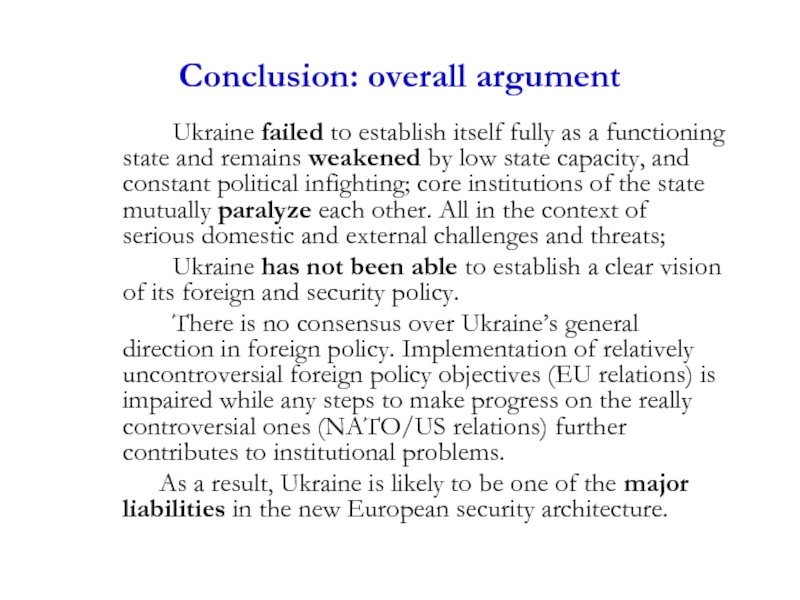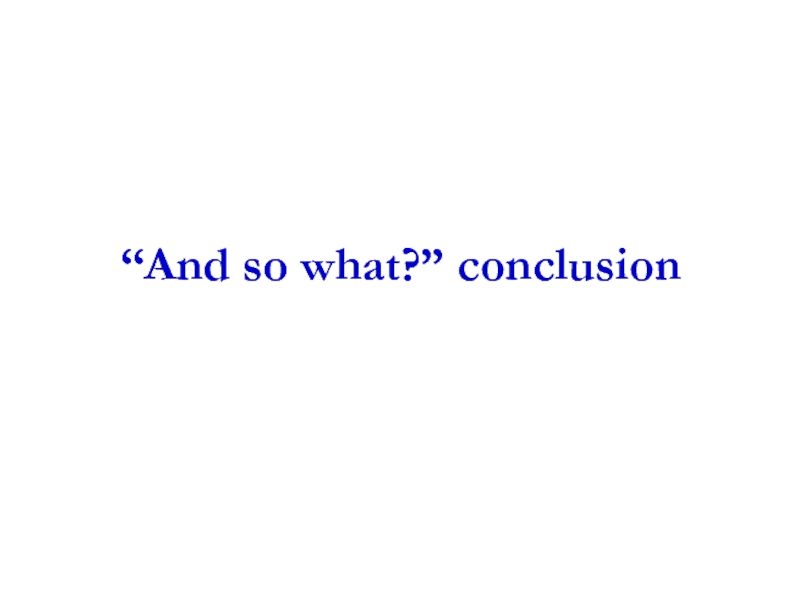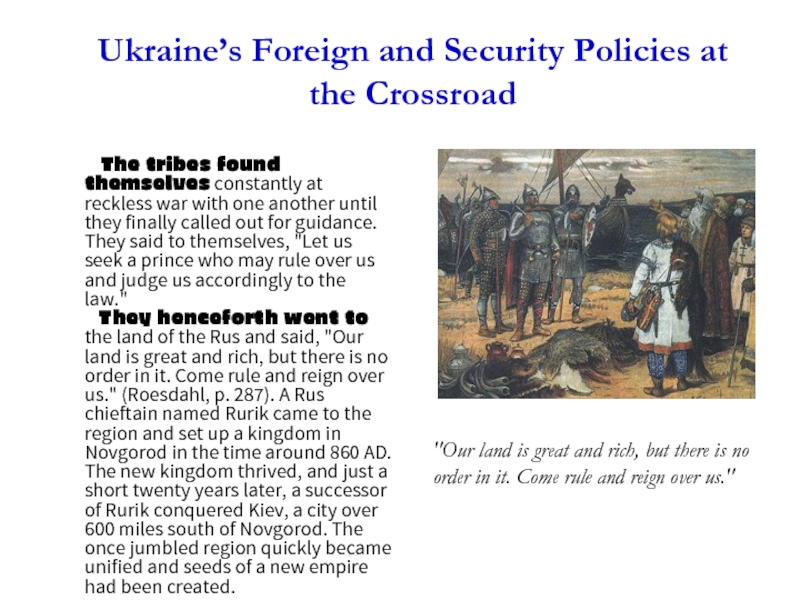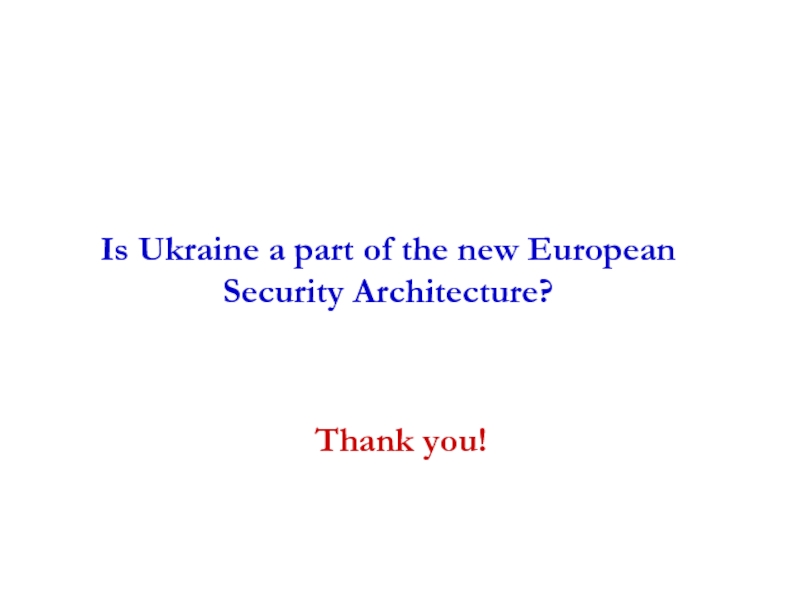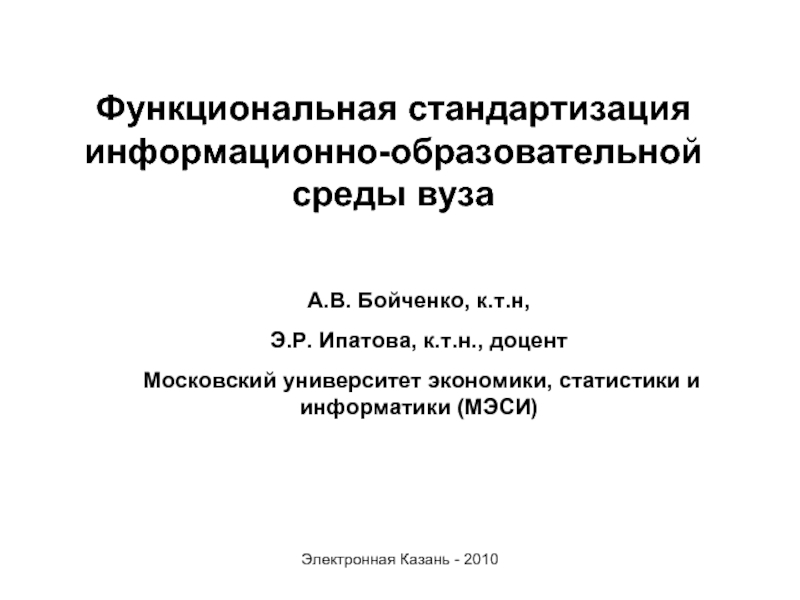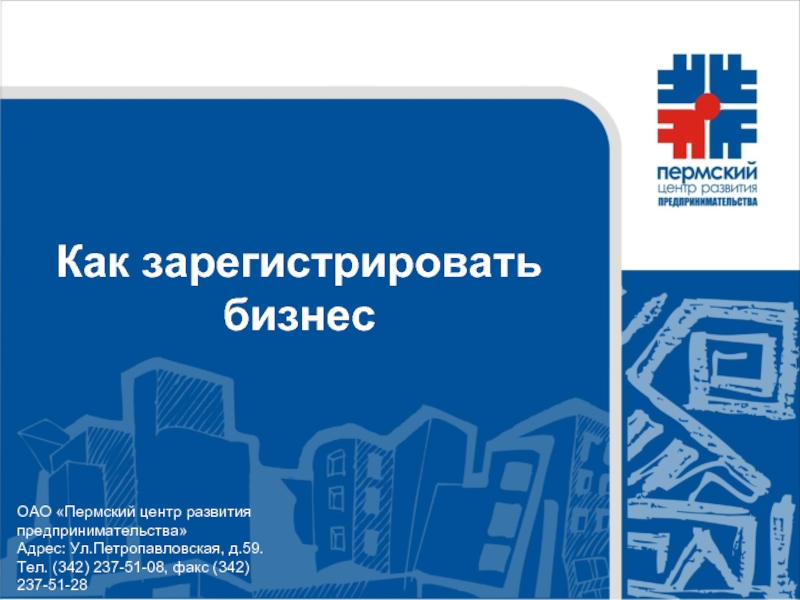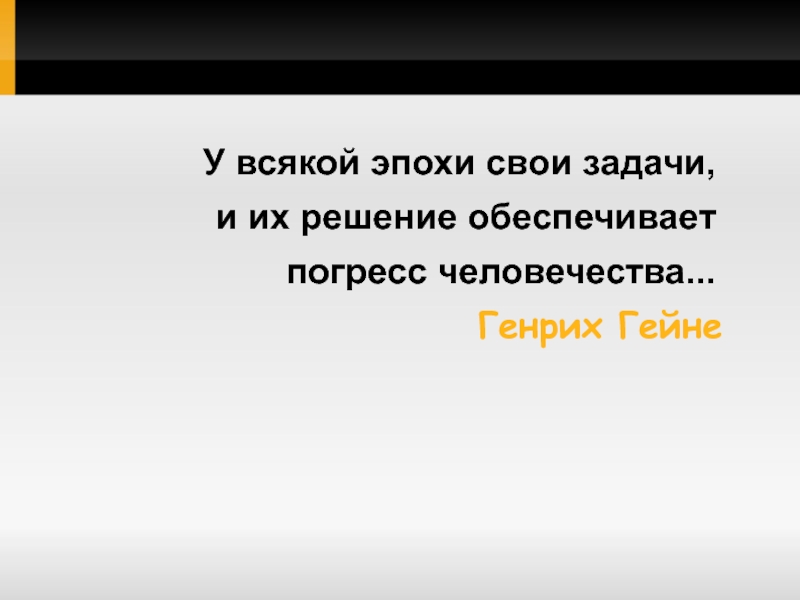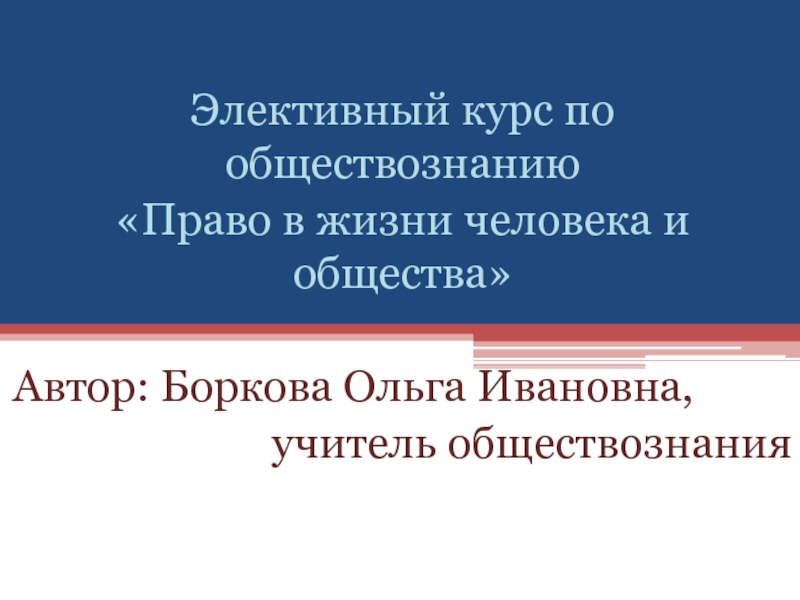Dr. Tetyana Malyarenko
- Главная
- Разное
- Дизайн
- Бизнес и предпринимательство
- Аналитика
- Образование
- Развлечения
- Красота и здоровье
- Финансы
- Государство
- Путешествия
- Спорт
- Недвижимость
- Армия
- Графика
- Культурология
- Еда и кулинария
- Лингвистика
- Английский язык
- Астрономия
- Алгебра
- Биология
- География
- Детские презентации
- Информатика
- История
- Литература
- Маркетинг
- Математика
- Медицина
- Менеджмент
- Музыка
- МХК
- Немецкий язык
- ОБЖ
- Обществознание
- Окружающий мир
- Педагогика
- Русский язык
- Технология
- Физика
- Философия
- Химия
- Шаблоны, картинки для презентаций
- Экология
- Экономика
- Юриспруденция
Ukraine’s Foreign and Security Policies at the Crossroad. Is Ukraine a part of the new European Security Architecture? презентация
Содержание
- 1. Ukraine’s Foreign and Security Policies at the Crossroad. Is Ukraine a part of the new European Security Architecture?
- 2. Ukraine’s Foreign and Security Policies at the
- 3. Global, regional factors/events, which impact changes in
- 4. Main risks and threats for Ukraine’s national
- 5. Legislation and public policy documents for Ukraine’s
- 6. State failure – the concept
- 7. The empirical case for comparative and regional
- 8. Failed States A Political Science/International Relations View
- 9. The Thirty States Most Vulnerable to Failure
- 10. Domestic scene for Ukraine’s foreign and
- 11. The Failed States Index
- 12. Ukraine: A Nation at Risk Driving forces
- 13. Development of a Market Economy Ukraine suffered
- 14. Socio-demographic issues According to data: in 1989,
- 15. Poverty The existence of poverty and destitution
- 16. Human insecurities in Ukraine Torture in pre-trial
- 17. Level of public trust/distrust to main public institutions
- 18. Relations with the United States and NATO
- 19. Unites States – Ukraine Chapter on Strategic
- 20. Defence and Security Cooperation
- 21. Ukraine and NATO - history of unrequited
- 22. If a referendum on Ukraine’s accession to
- 23. U.S. policy toward Ukraine and current/future tensions:
- 24. Ukrainian experts about U.S. foreign and security
- 25. American experts about U.S. foreign and security
- 26. Priority 2. Economic, trade and energy cooperation
- 27. The Project GUAM: Organization for democracy and
- 28. Implementation of the priorities of U.S. –
- 29. Ukraine – U.S. Chapter on Strategic Partnership:
- 30. Relations with Russia: from post-soviet to
- 31. Relations with the European Union: much ado
- 32. Evaluation of progress in Ukraine-EU cooperation on foreign and security policy
- 33. Question: Is Ukraine a part of the
- 34. Conclusion: overall argument
- 35. “And so what?” conclusion
- 36. Ukraine’s Foreign and Security Policies at the
- 37. Is Ukraine a part of the new European Security Architecture? Thank you!
Слайд 1 Ukraine’s Foreign and Security Policies at the Crossroad. Is Ukraine a
Слайд 2Ukraine’s Foreign and Security Policies at the Crossroad
Domestic scene for foreign and security affairs; key pressures and risk factors, associated with fragility of the Ukrainian State;
Ukraine’s foreign policy on three main directions (vectors), inc.
U.S.-Ukraine relations, EU-Ukraine relations, and Russia-Ukraine relations;
Ukraine’s security policy;
Is Ukraine a part of the new European Security Architecture?
Слайд 3Global, regional factors/events, which impact changes in the future Ukraine’s foreign
Global financial crisis (36% polled);
☻ The Presidential elections in the USA (22%);
Conflict in Georgia (16%);
The Presidential elections in Russia (8%)
Слайд 4Main risks and threats for Ukraine’s national security (Strategic assessment of
Слайд 5Legislation and public policy documents for Ukraine’s foreign and security policies
Foreign policy State Program “Main directions of Ukraine’s
foreign policy” (1993);
Security policy The Strategy of National Security of Ukraine”
(1997), (2007)
General line is to combine integration into the West with
cooperation with Russia, inc. projects in the military industry.
Ukraine’s strategy is clear; implementation is less evident
Слайд 6State failure – the concept
Concept of ‘fragile states’
State failure covers a wider range of civil conflicts, political crises, and massive human-rights violations that are typically associated with state breakdown” (the CIA, the USA)
State failure is a gradual process and that states engulfed in it fall into four broad categories: weak, failing, failed and collapsed states
Weak, failing, failed and collapsed states—the most common adjectives used in this context—were considered, quite correctly, as sources of insecurity and instability beyond their own boundaries, creating more or less complex humanitarian emergencies
Слайд 7The empirical case for comparative and regional perspective: LICUS (The World
Слайд 8Failed States
A Political Science/International Relations View on State Failure
Collapsed States
Africa: DRC,
Asia: Lebanon, Tajikistan
Europe: Albania, Bosnia and Herzegovina
Failed States
Africa: Angola, Burundi, DRC, Liberia, Sierra Leone, Sudan
Asia: Afghanistan, Iraq, Nauru, Solomon Islands
Europe: Albania, Bosnia and Herzegovina
Failing States
Africa: Ivory Coast, Zimbabwe
Asia: Indonesia, Iraq, North Korea
Americas: Colombia, Venezuela
Europe: Albania, Moldova
Weak States
Africa: Burkina Faso, Central African Republic, Chad, Ghana, Guinea, Kenya, Madagascar, Mali, Malawi, Niger, Nigeria
Asia: Burma, Cambodia, Fiji, Georgia, Indonesia, Kyrgyzstan, Laos, Lebanon, North Korea, Papua New Guinea, Philippines, Solomon Islands, Sri Lanka, Tajikistan, Turkmenistan, Yemen
Americas: Bolivia, Colombia, Ecuador, Guatemala, Guyana, Haiti, Paraguay, Venezuela
Europe: Belarus, Moldova, Ukraine
Fragmented States
Africa: Ethiopia, Nigeria, Somalia, Sudan
Asia: Azerbaijan, Georgia, Papua New Guinea, Solomon Islands, Sri Lanka
Americas: Colombia
Europe: Bosnia and Herzegovina, Cyprus, Moldova, Serbia and Montenegro, (Kosovo)
Слайд 9The Thirty States Most Vulnerable to Failure
(Fund for Peace Failed
Africa: Cote d'Ivoire (1); Dem. Rep. of the Congo (2); Sudan (3); Somalia (5) ; Sierra Leone (1); Chad (7); Liberia (9); Rwanda (12); Zimbabwe (15); Guinea (16); Burundi (18); Central African Republic (20); Kenya (25); Uganda (27); Ethiopia (30)
Americas: Haiti (10); Colombia (14); Dominican Republic (19); Venezuela (21)
Asia: Iraq (4); Yemen (8); Afghanistan (11); North Korea (13); Bangladesh (17); Burma/Myanmar (23);
Uzbekistan (24); Bhutan (26); Laos (28); Syria (29)
Europe: Bosnia and Herzegovina (22);
Слайд 10Domestic scene for Ukraine’s foreign
and security policy
Failed states: “those
Слайд 12Ukraine: A Nation at Risk
Driving forces of state fragility:
Weak state institutions,
political instability, misbalanced
vulnerable economy, socio-
demographic issues, poverty,
sharp confrontation between elite
groups, ineffective and bloated
State apparatus, dysfunctional
state-level strategic management
mechanisms and decision-making
methods that are opaque,
detached, politicised, and
uncoordinated
Слайд 13Development of a Market Economy
Ukraine suffered from a permanent crisis in
Among post-soviet states Ukraine, along with Moldova, Georgia and Tajikistan has minimal real GDP compared to 1991 (e.g. in 2007 real GDP of Ukraine is 75% of its GDP in 1991).
Ukraine’s economy depends heavily on exports (46% of GDP). At the same time Ukraine also depends on imports of energy, especially Russian natural gas, to meet some 85% of its annual energy requirements
New economic crisis. GDP will decrease 5-7% in 2009
“Ukraine is in pre-default situation and has already lost its chance to reform economy and industry” – experts say.
Слайд 14Socio-demographic issues
According to data: in 1989, the population of Ukraine numbered
The causes of the decline are: a reduction in the birth rate, an increase in the death rate, caused by the unsatisfactory state of the health; low quality of the health care system, and an excess of the level of emigration.
Слайд 15Poverty
The existence of poverty and destitution was officially admitted in Ukraine
Over the past ten years, the human development index has been consistently low: Ukraine occupies the 91st place among UN member states in 2008. Thus there are grounds for predicting that poverty will be a persistent and chronic problem
Слайд 16Human insecurities in Ukraine
Torture in pre-trial detention facilities;
Limitation on mass media
Deaths in custody under suspicious circumstances;
Violent hazing of conscripts;
Government monitoring of private communications and movements of individuals without judicial oversight,
Anti-semitic acts;
Violence and discrimination against children and women;
Trafficking in persons;
Frequent harassment of minorities
Слайд 18Relations with the United States and NATO
The Chapter of American-Ukraine
Agreement on establishment of strategic relationship (1996);
U.S. support for Ukraine’s eventual membership in NATO (2006);
Ukraine was selected as an eligible state to receive assistance from the Millennium Challenge Corporation (2006);
U.S.-Ukraine Charter on Strategic Partnership (December 2008)
Слайд 19Unites States – Ukraine Chapter on Strategic Partnership, December 2008
Defence and security cooperation;
Economic, trade and energy cooperation;
Strengthening of democracy and rule of law;
Cultural exchange
Слайд 20Defence and Security Cooperation
“Working within the
…to strengthen Ukraine’s candidacy for NATO membership” (U.S.-Ukraine Charter on Strategic Partnership, Section II)
Слайд 21Ukraine and NATO - history of unrequited love?
The Code of Conduct on Military and Political Aspects of Security (1994)
The Charter on a Distinctive Partnership between Ukraine and NATO (1997)
NATO-Ukraine Commission (NUC)
NATO-Ukraine Action Plan and Annual Target Plans since 2003
April 2005 NATO Intensified Dialogue on Ukraine’s membership aspirations and related reforms
Main areas of Ukraine-NATO cooperation now are:
Developing civil emergency planning;
Disaster response capabilities;
Security sector reform;
Countering terrorism;
Countering organized crime
Ukraine and NATO - history of unrequited love?
Слайд 22If a referendum on Ukraine’s accession to NATO would take place
Слайд 23U.S. policy toward Ukraine and current/future tensions: Strategic Partnership for Stability
Слайд 24Ukrainian experts about U.S. foreign and security policy toward Ukraine (Razumkov
Слайд 25American experts about U.S. foreign and security policy toward Ukraine (U.S.
Слайд 26Priority 2. Economic, trade and energy cooperation
Objectives:
Modernization of
The US – EU – Ukraine trilateral dialogue on energy security;
Support for direct contract negotiations between Ukraine, Kazakhstan and Turkmenistan
Main factors/recent events:
Russia bought all volume of gas, which Turkmenistan and Kazakhstan
might export on Western directions for 20 years
Gas Exporting Countries Forum, Russia, 2008;
Decision of the ICJ from February 3, 2009 : Ukraine lost about 80%
of the Black Sea continental shelf and economic zone in favor of
Romania; Ukraine will bring a case against Russia to the ICJ;
Слайд 27The Project GUAM: Organization for democracy and economic development: Georgia, Ukraine,
Initially established as regional geo-economical project (transit of oil, energetic security, free trade zone and even peace-keeping operations);
Main challenges for this organization now are: (a) loss of urgency; (b) changes in the Black Sea security architecture; (c) absence of clear rules on the energetic market of the EU; (d) no common position towards frozen ethnic conflicts
Слайд 28Implementation of the priorities of U.S. – Ukraine Strategic partnership: Economic
Ukraine’s export to: Russia (23,7%, increased 36,5% to 2006), Turkey (7,2%), Italy (4,3%), Poland (3,4%), Germany (2,7%), the USA (1,3%);
Ukraine’s import from: Russia (23,6%, increased 56,5% to 2006), Germany (8,3%), Turkmenistan (6,3%), China (6,3%), Poland (5,1%), the USA (0,1%)
Direct foreign investments to Ukraine: Cyprus (22,7%), Germany (18,1%), the Netherlands (8,6%), Austria (6,8%), UK (6,2%), Russia (5,1%), France (4%), the USA (3,4%)
Слайд 29Ukraine – U.S. Chapter on Strategic Partnership:
hard realistic core?
Without Ukraine, Russia ceases to be a Eurasian empire. Russia without Ukraine can still strive for imperial status, but it would then become a predominantly Asian imperial state, more likely to be drawn into debilitating conflicts with aroused Central Asians, who would then be supported by their fellow Islamic states to the south”..
Zbigniew Brzezinski The Grand Chessboard
Слайд 30Relations with Russia: from post-soviet
to Central European State ?
General
Ukraine relations is more
conflicted now:
Russia lost the role of key player in Ukrainian domestic politics;
Main tensions: trade wars; energy security; NATO; unsettled disputes in maritime borders, legal status of the Crimea; Sevastopol and the Russian Black Sea Fleet
Слайд 31Relations with the European Union: much ado about nothing?
EU-Ukraine Partnership and Cooperation Agreement (1998), negotiations about advanced agreement have been carried out;
Joint EU-Ukraine Action Plan (2005, 2006, 2007, 2008);
Ukraine is included in the EU’s Neighbourhood Policy (ENP), designed to draw several countries closer to the EU and promote democratic reforms;
Agreement with the EU, allowing Ukraine to participate in EU crisis management operations (civilian and military crisis management operations, 2005).
Слайд 33Question: Is Ukraine a part of the new European Security Architecture?
Sure,
It is simply too big not to be.
The main question, though it, is it part of the problem or the solution?
All my argument would point to Ukraine being a potentially major problem, precisely because it’s state institutions are so weak and the country therefore rather fragile.
So at this stage, it’s less a question of being pro-Russian or pro-Western, but rather to have a clear vision of its place in the new European security architecture and the capacity to implement this vision.
Слайд 34Conclusion: overall argument
Ukraine failed to
Ukraine has not been able to establish a clear vision of its foreign and security policy.
There is no consensus over Ukraine’s general direction in foreign policy. Implementation of relatively uncontroversial foreign policy objectives (EU relations) is impaired while any steps to make progress on the really controversial ones (NATO/US relations) further contributes to institutional problems.
As a result, Ukraine is likely to be one of the major liabilities in the new European security architecture.
Слайд 36Ukraine’s Foreign and Security Policies at the Crossroad
They henceforth went to the land of the Rus and said, "Our land is great and rich, but there is no order in it. Come rule and reign over us." (Roesdahl, p. 287). A Rus chieftain named Rurik came to the region and set up a kingdom in Novgorod in the time around 860 AD. The new kingdom thrived, and just a short twenty years later, a successor of Rurik conquered Kiev, a city over 600 miles south of Novgorod. The once jumbled region quickly became unified and seeds of a new empire had been created.
"Our land is great and rich, but there is no order in it. Come rule and reign over us."
